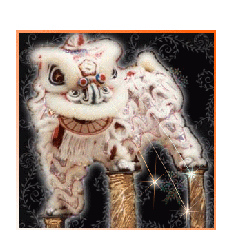
Lion dance is a form of traditional dance in Chinese culture, in
which performers mimic a lion's movements in a lion costume. The lion
is enacted by two dancers. One handle the head, made out of strong
but light materials, the other plays the body and the tail under a
cloth that is attached to the head. The Lion Dance is accompanied by
three musicians, playing a large drum, cymbals and gong. A Little
Buddha teases it with a fan or a giant ball. The head dancer can move
the lion's eyes, mouth and ears for expression of moods. |
 |
|
In a lion dance, the dancers move around
energetically, performing a wide variety of tricks including
acrobatics like jumping up onto each other's shoulders, and the
dance generally follows a rough narrative, with the lion first
emerging slowly and then growing bolder and capering through the streets. Because lion dancing required physical skills, many lion
dance Din Tao are associated with martial arts organizations.
Lion Dance is not only performed during the New Year period, but
also in the celebrations and festival time of local temples. This ancient tradition is said to bring luck and good fortune, as lions
are viewed as lucky animals in Chinese culture.
People often can't tell the difference between a dragon dance and a
lion dance. There are two ways to tell the difference. First, a lion dance is operated by two people, while a dragon dance needs many
people. Second, in a lion dance, the performers' faces are covered, since they are inside the lion. In a dragon dance, the performers can
be seen since the dragon is held upon poles.
|